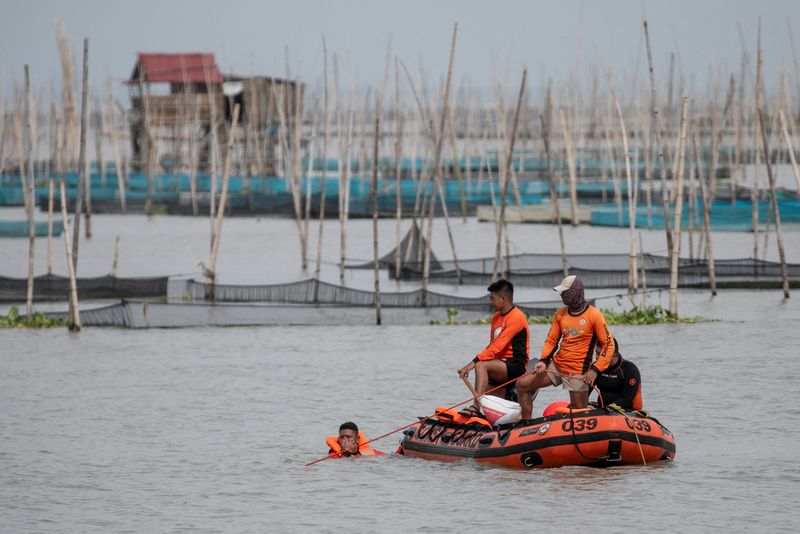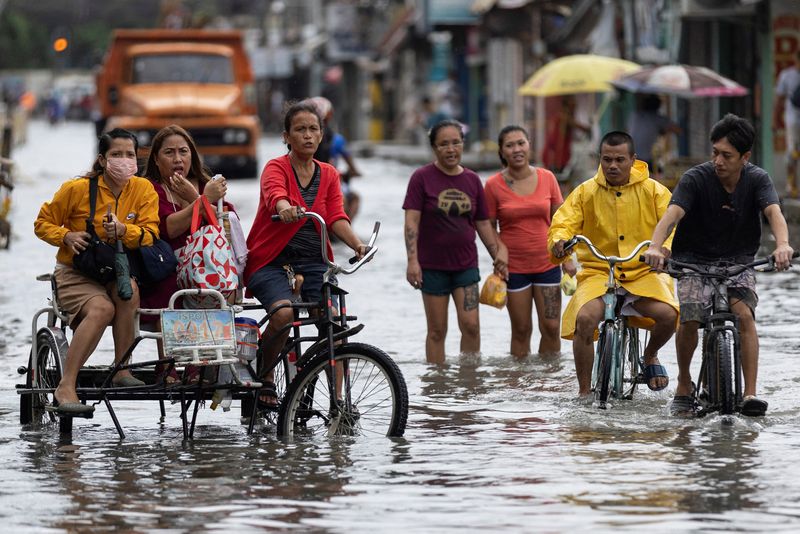By Bernard Orr and Yimou Lee
BEIJING/TAIPEI (Reuters) -Typhoon Doksuri swept into southern China on Friday, unleashing heavy rain and violent gusts of wind that whipped power lines and sparked fires, uprooted trees and forced factories and shopping malls to shut.
The typhoon is the second-strongest to hit southeastern Fujian province since Typhoon Meranti in 2016 and it forced the closure of schools, businesses and the evacuation of workers from offshore oil and gas fields, state media said.
Doksuri has affected more than 724,600 people, said state-run CCTV, with 124,400 people evacuated and resettled. So far, the storm has caused direct economic losses of 52.27 million yuan ($7.30 million), it said.
In the Fujian port city of Quanzhou, 39 people were reported to have suffered minor injuries, and more than 500,000 homes lost power, according to the government's official WeChat account.
There were no immediate reports of fatalities. In 2016, at least 11 people died when Meranti made landfall near the port city of Xiamen.
Doksuri's wind speed was clocked at 137 kph (85 mph) as of 1 p.m (0500 GMT), according to the National Meteorological Center.
Hourly rainfall in Xiamen, Quanzhou and Putian exceeded 50 mm (2.165 inches), according to the China Meteorological Administration (CMA).
"The whole of Xiamen didn't go to work this morning," a local resident, surnamed Zhuang, said.
"There are no cars on the roads, and factories and shopping malls are closed. Guess (NYSE:GES) people are scared after Meranti."
DAMAGE
Social media video showed power lines sparking and bursting into flames as winds thrashed Jinjiang, a city of two million, while in Quanzhou massive trees were uprooted and left in the middle of roads.
A woman's voice in the background of one video shouted, "so many fallen tress. Some are broken down. It is a mess. This is too much. It is horrible."
Social media videos showed strong winds blowing a large incense burner across the ground at a temple in Jinjiang and residents made makeshift barriers at doors to stop rain from flooding into apartments.
Residents told Reuters they had experienced power and water cuts in some areas of Jinjiang and Quanzhou.
Doksuri, the second typhoon to make landfall in China in less than two weeks, will move north and dump heavy rain on 10 provinces, weather forecasters predict.
It is expected to continue to move in a north-westerly direction and weaken in intensity, China's CMA said.
The agricultural province of Anhui, which grows corn, rice, soybean and cotton, lies in the storm's path. Analysts say it should weaken by the time it reaches the province and they are watching closely for potential crop damage.
FERRY OVERTURNS
Typhoon Doksuri has already left a wake of death and destruction in its path as it moved from the Philippines across southern Taiwan.
In the Philippines, a ferry sank near Manila, killing at least 26 after passengers, alarmed by strong winds, rushed to one side of the boat and caused it to overturn. As many as 36 people have been killed this week during Doksuri's transit off the northern Philippines.
In southern Taiwan, the storm toppled trees and cut power to hundreds of thousands of homes, prompting authorities to shut businesses for a second day on Friday and warn of extreme winds, landslides and floods. Taiwan's weather bureau assigned its second-strongest typhoon level to the storm.
A "hurricane-force-wind" alert was issued in the Taiwanese islands of Penghu and Kinmen, where residents were warned to brace for gusts of more than 155 kph (96 mph).
The storm had cut power to more than 278,000 homes across Taiwan and downed hundreds of trees in Kaohsiung. Rainfall of more than 1 metre was recorded in the mountainous eastern and southern parts of the island.

More than 200 domestic and international flights were suspended or delayed on Friday and railway services between southern and eastern Taiwan were halted.
($1 = 7.16 yuan)
